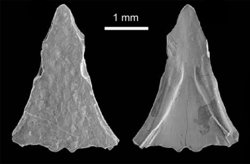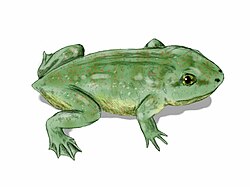| Wesserpeton Temporal range: Early Cretaceous, | |
|---|---|
 | |
| The holotype of W. evansae - an isolated azygous frontal, in dorsal (left) and ventral (right) view, from the Lower Cretaceous of the Isle of Wight, southern England. | |
| Scientific classification | |
| Kingdom: | Animalia |
| Phylum: | Chordata |
| Class: | Amphibia |
| Order: | † Allocaudata |
| Family: | † Albanerpetontidae |
| Genus: | † Wesserpeton Sweetman & Gardner, 2012 |
| Species: | †W. evansae |
| Binomial name | |
| †Wesserpeton evansae Sweetman & Gardner, 2012 | |
Wesserpeton is an extinct genus of albanerpetontid amphibian known from the Isle of Wight, southern England, [1] and Balve, Germany. [2]



